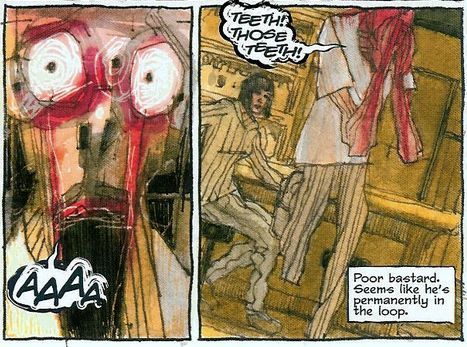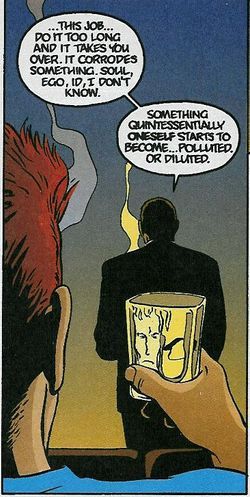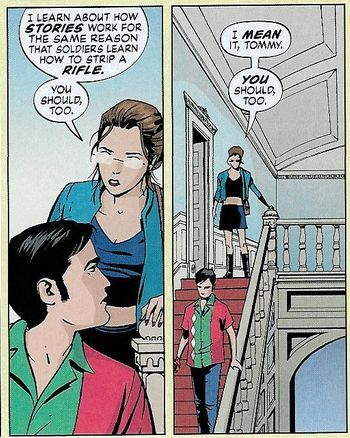And now, back to your irregularly-scheduled programming (how does Burgas write reviews so quickly?). Three trade paperbacks beneath the fold: Human Target: Chance Meetings, Unwritten vol. 1, and The Veil.
Human Target: Chance Meetings by Peter Milligan, Edvin Biukovic, Javier Pulido, Lee Loughridge, Dave Stewart, Robert Solanovic, Todd Klein, and a li'l bit o' Tim Bradstreet (DC/Vertigo)
If you came to this collection because you really like that Fox TV show that happens to share the same name as this comic, you're out of luck-- it shares the title, the name "Christopher Chance," and nothing else. However, if you don't mind paying 15 dollars for 200 pages of some of the best comics from the late twentieth and early twenty-first centuries, well, you've won the day.
Make no mistake, this is "Good" Milligan, the Jekyll to "Paycheck" Milligan's Hyde. In fact, this is "Great" Milligan, who may have finally found the perfect summation of his pet themes, and in a character he didn't create. Much like Christopher Chance, however, Milligan so inhabits the character and body of the Human Target, that it might as well be his own creation. After all, this is a book about shifting identities, where nothing is as it seems. Christopher Chance is a bodyguard, of sorts, who doesn't just protect you-- he becomes you, impersonating you until the threat can be revealed and eliminated. Unfortunately, he impersonates people a little too well, and sometimes forgets who he is, which can be trouble when his former assistant comes back into his life, also thinking he's Christopher Chance. For each of these masters of disguise, hell isn't other people-- hell is the self, and other people, the escape. Meanwhile, we've got a lady assassin who is also a housewife, a priest with discretions, and a gangster with a heart. In the back half of the book, the story goes to Hollywood, where everyone is an actor, as fake as Chance. Perhaps these characters can escape their fates, however, and become better people-- or at least, other people.
Edvin Biukovic illustrates the original 1999 mini-series here; he died of a brain tumor shortly after its publication. Even if this were the only comic he ever drew, it would be enough for us to remember him by, for it's a great bit of work.Biukovic's art reminds me of a fellow, late great artist-- Mike Wieringo-- 'Ringo, that is, by way of Eduardo Risso. His lines are as fluid as the characters' identities, but he swathes the pages in ink, wrapping the Human Target's world in wet shadow. Combined with what may be Lee Loughridge's finest coloring efforts, it becomes perfect action crime comic art, creating a lush world rich in detail and character. Javier Pulido, who steps in on the back half, the follow-up graphic novel Final Cut, uses a sparer style, with lithe figurework and bold, inky brushwork. With Dave Stewart's always-excellent colors, it becomes effective art, variant in style from Biukovic's, but similarly resonant in tone.
I hope the television series succeeds, so that Vertigo finally collects the full Human Target run in trades. There is a "1" on the spine of this book, after all.
The Unwritten: Tommy Taylor and the Bogus Identity by Mike Carey, Peter Gross, Chris Chuckry, Jeanne McGee, Todd Klein, and Yuko Shimizu (DC/Vertigo)
Let me start by saying that this is one of the better-smelling comics in ages. It carries the scent of wooden furniture. Mmm.
A lot of Unwritten feels like Vertigo-by-numbers. Stories about stories? Check. A "road trip" serial structure? Check. An everyman figure who turns out to be super-special and is thrust into a world he doesn't understand? Yep, that too. A mystery thriller plotline and a spare yet expressive cartooning line? I think you see where this is going. Reading this first volume, one can see similarities to Fables, Y the Last Man, American Virgin, The Books of Magic (or more accurately, Harry Potter), and more. That doesn't mean it's not a good comic, however, because it is.
The Unwritten follows el viaje misterioso of Tom Taylor, a Christopher-Robin-esque figure who tours the convention circuit, trading on his vanished father's fame, and his similarities to the protagonist said father's top-selling Tommy Taylor fantasy novels, a dead-on riff of the Harry Potter series. This being a Vertigo series, of course, strange events begin to occur: Tom's accosted by a man who appears to be Tommy's antagonist from the books, a mystery girl sets him up as a savior, a fiction come to life, and magic and death start following Tom around.
Mike Carey's story includes a lot of text-- and subtext-- on the power of words and storytelling. He sets up what looks to be a travelogue the series will follow-- real places tied to important fictions, this opening volume taking a visit to the house in which Frankenstein was born. The most intriguing part of this opening volume is the included fifth issue, a one-off that spins Rudyard Kipling's life into the shady mysteries that form the mythology of this series, involving a terribly mysterious organization trying to direct the course of the world's fictions. All the mystery is effective-- it makes me want to see where the story plans to go. I think that makes it a successful plot. I also want to see more of the world of Tommy Taylor, and how those 13 (or 14) novels fold their way into Tom Taylor's life.
Peter Gross' art is more than serviceable, but it's the slight shifts in style I like the most. In the Kipling issue, for instance, his lines take on a thinner quality, the illustrations more resembling those you might find in the time period, yet still solidly Grossian. I'm also pleased that the colorists haven't fallen into using the standard muddled brown palate that many Vertigo books have taken on.
If Fables is Vertigo's flagship title, I can see this one following close behind, similar in theme and content but variant in approach. Anyway, the book's only ten bucks. You should pick it up.
The Veil by El Torres and Gabriel Hernandez (IDW)
The premise and atmosphere of this book really grabbed me right at the beginning-- it stars Chris Luna, a private detective whose clients are ghosts that only she can see and hear, a la Sixth Sense, and involves her being called back to her childhood home, invoking the literal and metaphorical ghosts of the accident that gave her this strange gift. Okay, sold. I love high concepts-- you could sell a TV show on that premise. Unfortunately, the comic diverts quickly into a different kind of horror story, one a little more generic, and a little less sensical.
El Torres-- who I guess fights crime at night, disguised as a luchador-- writes a pretty great female protagonist in Chris Luna, seeming the world's greatest detective, but actually a damaged, lonely woman constantly haunted by ghosts and traumatic memories alike. I usually detest first-person narrative captions, but they work here, not just in explaining intricacies of the plot that might not be otherwise evident, but in letting us into Chris's head, allowing the reader to haunt her, as well. The first of the four issues collected here acts as a nifty pilot episode that solves one mystery, introduces the reader to the milieu, and then kicks the plot off with Chris returning to her hometown, where something bad is lurking.
In fact, it reminds me of Mark Waid's series The Unknown, in that it starts with a cool detective story that becomes more wildly fantastic as it progresses, but I feel here as I do with Waid's series-- that the last act doesn't live up to the first one. A dark, malevolent force lurks in the town and begins to pierce the veil between life and death, turning its residents into evil maniacs, and only Chris and her semi-hapful romantic interest, a local cop, can stop it. The plot goes off the rails somewhat, veering into Steve Niles territory, and the whole thing turns into something more generic-- a zombie story, or The Crazies, perhaps, with a Morrisonian psychological monster called the Slug Man, reminiscent of Crazy Jane's evil father from Doom Patrol, coming in at the end. Each issue progresses the story into stranger territory, but each issue also makes the story feel less unique and interesting, which is a shame.
The art, by Hernandez-- not one of the Los Bros, but a solo act-- fits the story pretty damn well. His style most reminds me of rusted metal and fire-tinged wood, which is fitting, as he brings us a character and world that has burnt and faded, one that can not gleam, heavy with foreboding overtones. The colors, as well, are washed out, heavily reliant on browns, in keeping with Chris Luna's view of the world. The only bright colors we see are the searing fuchsias of her nightmarish memories and flashes beyond the titular veil.
Horror comics buffs might enjoy this considerably, although it may feel all too similar in its plot turns. But hey, Burgas liked it, right? And you all like Burgas. Check it out if you feel it's up your alley.



